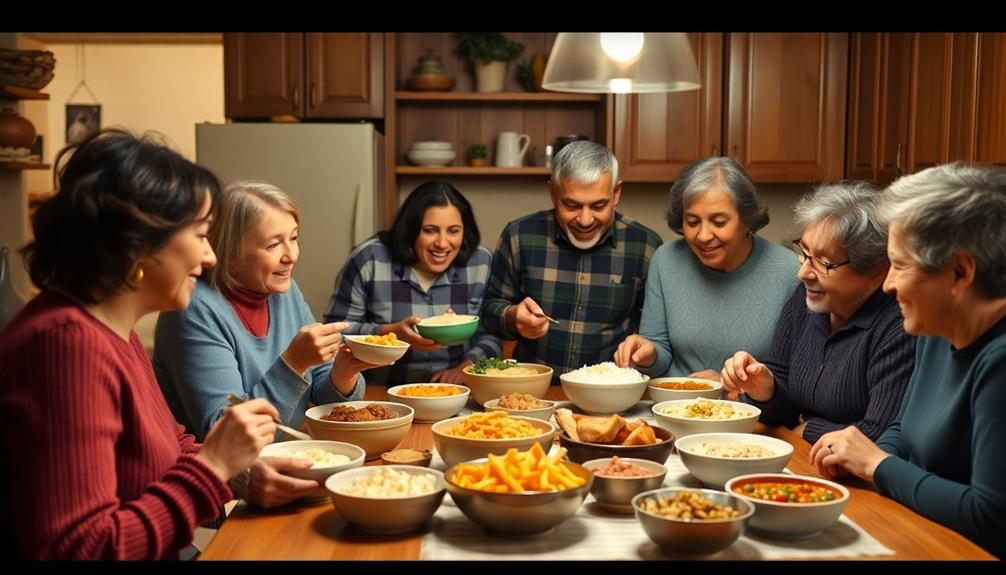The neuroscience of food aversions you develop in adulthood includes emotional responses, learned experiences, and complex brain mechanisms. Your amygdala integrates taste and smell, linking them to emotional memories. When you experience illness after eating a particular food, your brain can create a conditioned taste aversion. Novel foods and changes in your metabolic state can also trigger these aversions. Understanding these factors is essential for managing your food choices. By exploring treatment options, you can overcome these challenges and improve your relationship with food in meaningful ways. There's much more to uncover about these fascinating processes.
Key Takeaways
- Food aversions often develop suddenly due to hormonal changes, particularly during pregnancy, affecting taste and smell perception.
- Conditioned taste aversion links negative experiences with specific foods, reinforcing learned aversions through neural pathways in the brain.
- The amygdala is crucial for integrating emotional responses with taste, significantly influencing the strength of food aversions.
- Emotional reactions, such as disgust, can lead to physiological responses, further entrenching food aversions in individuals.
- Treatment for food aversions requires personalized strategies, including cognitive behavioral therapy and desensitization techniques for gradual exposure to aversive foods.
Understanding Food Aversions
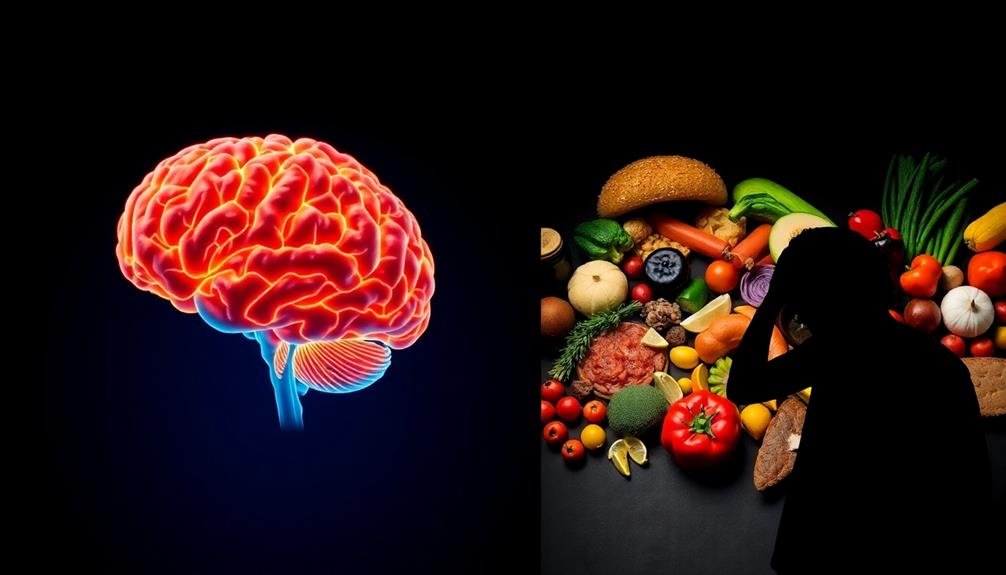
Food aversions often emerge suddenly, leaving you with an intense dislike for foods you once enjoyed. This phenomenon can be particularly acute during pregnancy, where about 70% of individuals experience such aversions due to hormonal changes affecting taste and smell.
Additionally, certain foods, such as Mushroom Masala, may become unappealing despite their rich flavors and enjoyable textures. These aversions may also be tied to conditioned taste aversion, where negative experiences with a food create lasting repulsion.
For individuals with Autism Spectrum Disorder, sensory processing issues can amplify these food aversions, leading to strong emotional responses and extended meal times. You might find that some foods trigger nausea or anxiety, complicating your nutritional health.
In cases where food aversions are severe, a thorough evaluation is essential to rule out any underlying health conditions.
Managing food aversions often requires dietary adjustments and the use of desensitization techniques. These methods help you gradually reintroduce disliked foods in a controlled manner, aiming to lessen the negative responses over time.
Therapeutic support can also be beneficial, as it encourages you to explore the emotional roots of your aversions while ensuring you maintain a balanced diet despite these challenges.
Neural Mechanisms Involved
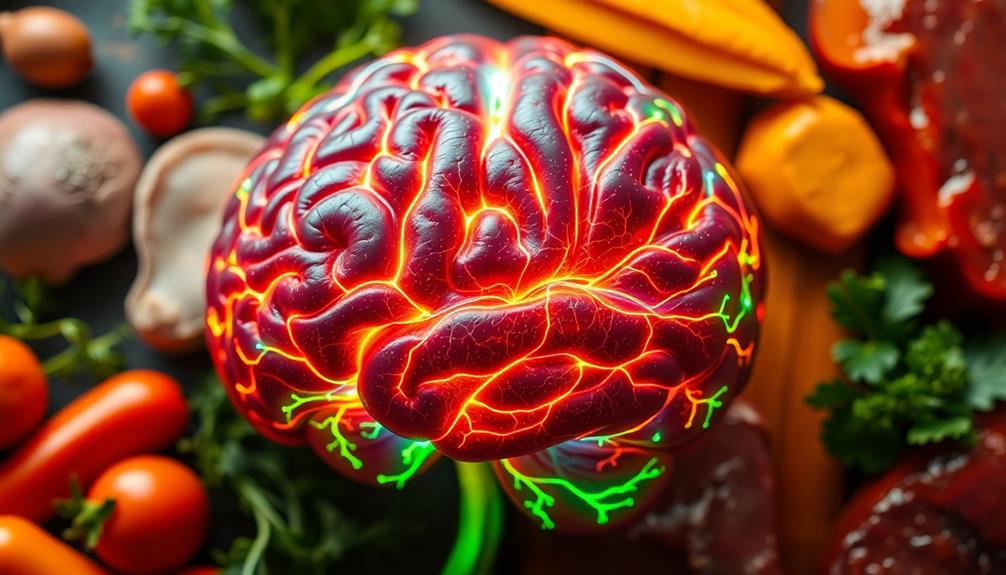
When you experience a food aversion, several neural pathways come into play, particularly within the amygdala and insular cortex.
These brain structures are essential for processing taste and linking it to negative experiences. For example, a dish like Red-Braised Pork Belly could evoke strong reactions if associated with an unpleasant event.
Understanding how these mechanisms work can shed light on why certain foods become off-limits for you after a single unpleasant encounter.
Neural Pathways in Aversions
Taste aversions arise from complex neural pathways that connect sensory experiences with visceral responses. When you experience food aversions, your brain engages various neural systems to form these connections. For instance, certain culinary experiences, such as the savory sautéed beef dish, can evoke strong emotional responses that may lead to aversions if associated with negative experiences.
The nucleus of the solitary tract (NTS) plays a significant role by receiving gustatory signals and integrating them with visceral information related to illness. This integration is fundamental for developing conditioned taste aversion.
The pontine parabrachial nucleus (PBN) helps associate the taste (conditioned stimulus) with the feeling of illness (unconditioned stimulus). Meanwhile, the insular cortex (IC) is essential for forming taste memories; damage here can hinder your ability to learn food aversions effectively. The amygdala also contributes to this process, as it's involved in both the acquisition and retrieval of conditioned taste aversions.
Key aspects of neural pathways in food aversions include:
- Gustatory signals processed by the NTS
- Integration of visceral information
- Long-term potentiation in the basolateral amygdala (BLA)
- The role of the insular cortex in memory formation
These intricate pathways underline how your brain learns and remembers negative experiences associated with certain foods.
Brain Structures Involved
Understanding the neural mechanisms involved in food aversions requires looking at specific brain structures that play critical roles in this complex process. The nucleus of the solitary tract (NTS) is essential for taste aversion learning, as it processes gustatory signals related to food intake and rejection. This is particularly relevant when considering comfort foods like a Loaded Baked Potato, which can evoke strong emotional responses tied to past experiences.
The area postrema detects toxins in the bloodstream and selectively contributes to taste aversion learning, although it doesn't influence aversions tied to all unconditioned stimuli (US).
Another key player is the pontine parabrachial nucleus (PBN), important for linking conditioned stimuli (CS), like taste, with unconditioned stimuli during conditioning, which is crucial for forming food aversions.
The insular cortex (IC) is significant in developing taste memory and aversions; lesions here reduce your ability to learn these aversions.
Lastly, the amygdala shows variable effects on taste aversion learning, underscoring its complex role in emotional responses related to food. Together, these brain structures create a network that helps you develop aversions to certain foods based on past experiences, enhancing your ability to avoid harmful substances.
Role of the Amygdala

How does the amygdala influence our food preferences and aversions? The amygdala plays an essential role in how you develop food aversions through its integration of taste, smell, and emotional responses.
For instance, experiencing a food like Nettle and Potato Soup for the first time during a negative event can create a lasting aversion. When you encounter novel tastes linked to negative experiences, the amygdala helps form strong aversive memories, which can lead to an avoidance of those foods. This associative learning process is important for survival behaviors.
- The basolateral amygdala (BLA) responds to both taste and odor stimuli.
- Lesions in the amygdala can cause rapid extinction of learned taste aversions.
- Increased amygdala activity correlates with stronger food aversions.
- It interacts with areas like the insular cortex and hippocampus for emotional processing.
Understanding the role of the amygdala is key to grasping why certain foods evoke strong negative reactions. Its involvement in retaining and retrieving aversive memories guarantees that once you've had a bad experience with a food, you're likely to avoid it in the future.
This mechanism serves as a protective measure, helping you navigate your food choices more safely.
Conditioned Taste Aversion
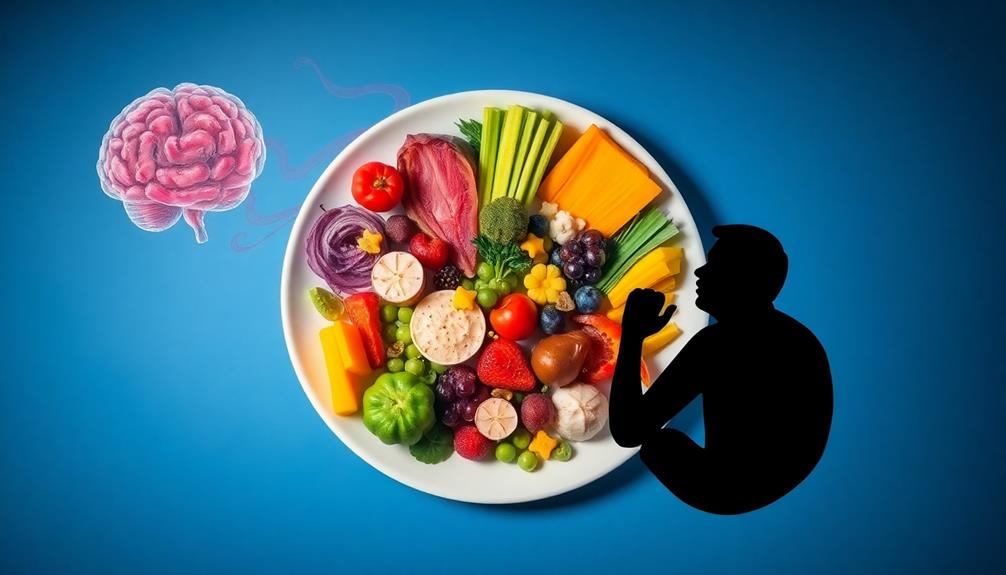
When you eat something that makes you feel sick, your brain quickly learns to associate that food with nausea. This learned aversion is driven by strong emotional responses and specific neural pathways, particularly involving the amygdala.
For example, a dish like Muamba De Galinha from Angola, rich in flavor and cultural significance, could become unappealing if it leads to a negative experience.
Understanding how these mechanisms work can help you recognize why certain foods become off-limits after just one bad experience.
Mechanisms of Taste Learning
Conditioned taste aversion (CTA) is a fascinating mechanism through which you can develop a strong dislike for a food after associating its taste with an unpleasant experience, such as illness. This powerful form of associative learning can happen after just one incident, making it particularly impactful.
The amygdala and insular cortex play critical roles in both forming and retrieving these food aversions, with the insular cortex specifically processing taste memory. Notably, the types of foods you may develop aversions to can vary based on cultural influences, such as the rich flavors found in Brazilian Cuisine, which may heighten the novelty of certain dishes.
Several factors contribute to how you experience CTA:
- Novelty of the food: New foods are more likely to trigger aversions.
- Metabolic state: Your body's current condition can influence your response.
- Prior experiences: Past interactions with similar tastes can shape your reactions.
- Individual differences: Each person's susceptibility to food aversions varies.
This robust mechanism can maintain aversions even after long gaps between eating the food and feeling sick.
Understanding CTA not only highlights how your brain learns and remembers tastes but also illustrates the complex nature of food aversions as a survival strategy.
Emotional Responses and Aversions
In the domain of food aversions, emotional responses play a vital role in shaping your experiences with certain tastes. When you consume a novel taste followed by illness, you often develop a conditioned taste aversion (CTA). This powerful mechanism can occur even after just one pairing of the food and the unconditioned stimulus (illness).
Your brain responds by activating the amygdala and insular cortex, areas important for aversion learning. Foods that are less familiar, such as Dorayaki (Red Bean Pancake), can be particularly susceptible to these reactions due to their unique flavors and textures. As a result, you might feel strong emotional responses like disgust or nausea, leading to physiological reactions such as gagging or vomiting when exposed to the aversive food again.
This response isn't limited to immediate aftermath; research shows that CTA can form even with a considerable delay between tasting the food and experiencing illness. This robustness explains why you may avoid new dietary options that seem risky.
Food aversions often target novel and less familiar foods, which can heighten your emotional reactions. Understanding these emotional responses is essential, as they greatly influence your food choices and overall relationship with what you eat.
Neural Pathways Involved
Understanding the neural pathways involved in taste aversions reveals how your brain processes and retains these experiences. Conditioned taste aversion (CTA) occurs when you associate the taste of a specific food with illness, leading to a long-lasting aversion.
This process engages several key areas in your brain, which can be influenced by cultural experiences with food, such as the rich flavors found in traditional dishes like Kue Putu. The nucleus of the solitary tract (NTS) processes gustatory signals and connects with other regions to facilitate learning.
The amygdala plays a significant role in acquiring and retaining these aversions, as lesions here can disrupt the learning process. The pontine parabrachial nucleus (PBN) is vital for forming the association between the taste (conditioned stimulus) and the feeling of sickness (unconditioned stimulus).
Long-term potentiation in the basolateral amygdala (BLA) enhances the learning mechanism, strengthening the aversion formed.
These neural pathways work together to guarantee that once you experience a food aversion, it's likely to stick around. By understanding these connections, you gain insight into how your brain prioritizes survival by avoiding potentially harmful substances.
Emotional and Sensory Processing
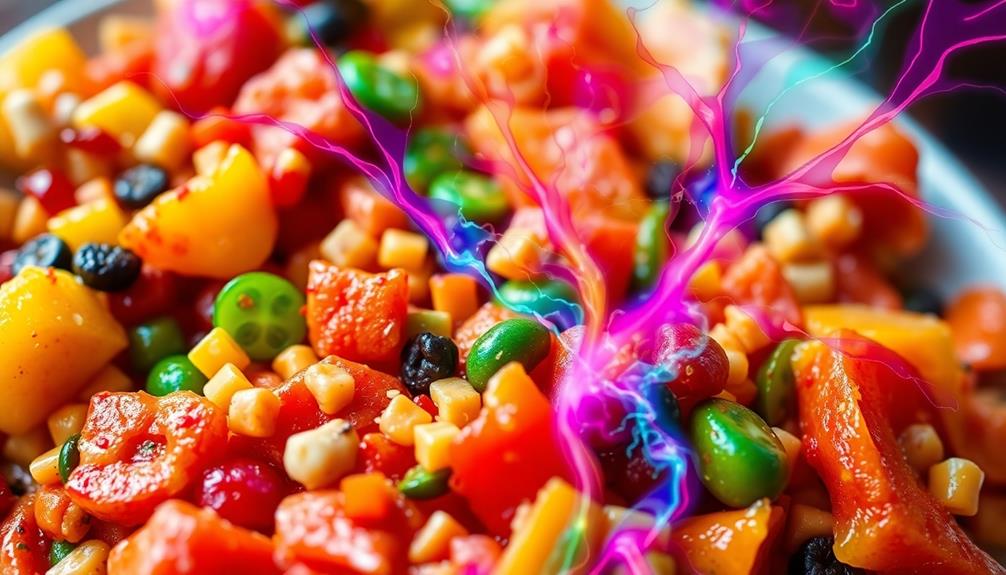
Food aversions often stem from complex emotional and sensory processing issues that greatly impact how adults experience and react to certain foods. Your emotional processing, particularly in the amygdala, plays a significant role in forming negative associations with specific foods.
When you've had traumatic experiences related to eating, such as trying unfamiliar dishes like Ethiopian cuisine, those memories can shape your aversions, making you associate certain tastes, smells, or textures with discomfort.
Sensory processing also comes into play, especially if you have heightened sensitivity to sensory inputs. This can amplify your reactions to food, leading to aversions that are often linked to feelings of nausea.
For individuals with autism spectrum disorder, these challenges can be even more pronounced due to difficulties in sensory integration and emotional regulation.
Moreover, the orbitofrontal cortex (OFC) is involved in how you perceive food rewards. Increased activation in the OFC when presented with high-calorie foods can complicate your relationship with those items, reinforcing aversions.
In this intricate web of emotional and sensory processing, your experiences shape the way you navigate your food choices, often leading to lasting food aversions.
Implications for Treatment

Steering through the complexities of food aversions requires a thoughtful approach to treatment that addresses both psychological and emotional factors.
To effectively combat these aversions, you'll need a personalized strategy that includes various therapeutic methods. Cognitive Behavioral Therapy (CBT) and Eye Movement Desensitization and Reprocessing (EMDR) can markedly help in addressing the underlying psychological factors.
Incorporating desensitization techniques is essential; gradual exposure to aversive foods paired with positive reinforcement can lead to improved dietary acceptance. Nutritional counseling is also vital, ensuring you find alternative food sources that meet your nutritional needs without risking malnutrition.
Consider these important elements in your treatment plan:
- Early intervention to prevent long-term health issues
- Understanding neurobiological mechanisms involved in food aversions
- Utilizing nutritional counseling for balanced diets
- Applying desensitization techniques to ease food fears
Frequently Asked Questions
What Is the Psychology Behind Food Aversions?
Food aversions stem from negative associations with certain foods, often triggered by past unpleasant experiences. Your brain learns to avoid these foods, influenced by emotional responses and psychological factors like trauma or heightened sensory sensitivity.
Can Adults Have Sensory Food Aversion?
Sure, adults can't possibly have sensory food aversions, right? But they do! You might find yourself repulsed by certain foods due to past experiences or sensory issues, leading to strong reactions like nausea or gagging.
How Do People Develop Taste Aversions Psychology?
You develop taste aversions through negative experiences linked to specific foods. When you associate a food with illness or discomfort, your mind creates a strong rejection response, making you avoid that food in the future.
Why Is My Body Suddenly Rejecting Food?
Your body might suddenly reject food due to negative experiences, heightened sensitivities, or stress. It's also possible that hormonal changes or sensory processing issues are influencing your taste preferences and causing aversions to previously enjoyed foods.
Conclusion
To sum up, food aversions developed in adulthood can be deeply rooted in our brain's wiring. Research shows that nearly 25% of adults experience some form of food aversion, often triggered by a negative experience. Understanding the neural mechanisms, particularly the role of the amygdala in emotional processing, can open doors for effective treatments. By recognizing these patterns, you can better navigate your own food preferences and potentially overcome aversions, enriching your culinary experiences.

